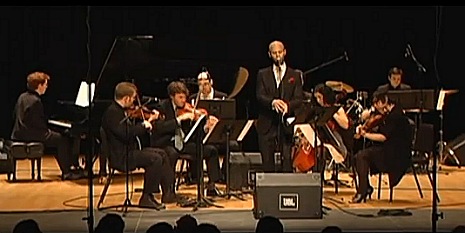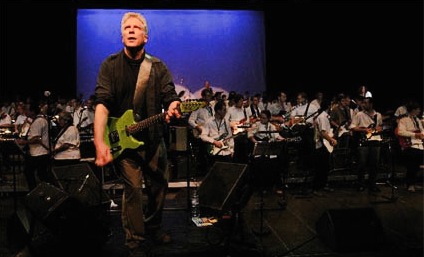Some notable NY concerts worth taking up space for:

Tuesday, Aug 4th, at Joe’s Pub ( 425 Lafayette Ave., NYC / Tickets: $15 at joespub.org or 212.967.7555) ACME (the American Contemporary Music Ensemble) is teaming up again with vocalist Craig Wedren, to present composer Jefferson Friedman’s genre-bending 3-song set titled On in Love, written for the ensemble and singer/songwriter Wedren (formerly of the band Shudder To Think). ACME and Wedren premiered On in Love in February at Columbia University’s Miller Theatre, and you can see video of that performance at Friedman’s own website. The concert at Joe’s Pub will also include John Cage’s String Quartet in Four Parts (performed by ACME) and his Aria (performed by Wedren). Wedren will also perform a set with his band and ACME strings.
And on Sunday afternoon, Aug 9th ACME‘s back in action at the Isamu Noguchi Museum (9-01 33rd Rd., L.I.C., NY / Info: www.noguchi.org or 718.204.7088 / FREE w/ $10 Museum admission), this time with the premiere of a new string quartet by ACME’s ace composer/violinist Caleb Burhans. You also get selections from J. S. Bach’s Art of the Fugue (arr. for string quartet), Jefferson Friedman’s String Quartet No. 3, and Mendelssohn’s String Quartet in F, Op. 80, so all-in-all a mighty nice deal.
stephanieberger2009.jpg)
Speaking of nice deals, nothing’s nicer than FREE! Which is just what it’ll cost you to experience the Asphalt Orchestra (Jessica Schmitz, piccolo; Alex Hamlin, Peter Hess and Ken Thomson, saxophones; Shane Endsley and Stephanie Richards, trumpets; Jen Baker and Alan Ferber, trombones; Ken Bentley, sousaphone; Sunny Jain, Nick Jenkins, and Yuri Yamashita, percussion) as they open Lincoln Center Out of Doors Wednesday, August 5. The band will perform the next four nights, Thursday-Sunday, August 6-9. Performances will take place nightly at 7:00 P.M. in different locations across the Lincoln Center campus.
The scrappy group’s debut program spans an amazing range of material, including new commissions by Tyondai Braxton of Battles, Stew and Heidi Rodewald of The Negro Problem and Passing Strange, and celebrated Balkan musician-composer Goran Bregovic, plus music by Björk, jazz legend Charles Mingus, Swedish metal pioneers Meshuggah, and those classic instigator/composers Conlon Nancarrow and Frank Zappa.

For those of you who’d love to slouch off to play at the Hamptons (though has it ever stopped raining enough to think about sea and sand?), yet want to stay moderately ‘culturefied’ while you’re at it, the Bridgehampton Chamber Music Festival is off and running. In addition to the warhorses, there are two actually quite wonderful contemporary concerts taking place:
Real Quiet will be heard on Aug 6th in a program featuring the US premiere of Pimpin’ by Jacob Ter Veldhuis as well as works by Evan Ziporyn, Chinary Ung and Brett Dean.
Then on Aug 11th , Brooklyn Rider performs “Crosstown” and “Plume” by composer Ljova (Lev Zhurbin) along with works by Philip Glass, Toiva Karki and Komitas Vardapet.


 For all you Angelenos and outlying: word from
For all you Angelenos and outlying: word from 
stephanieberger2009.jpg)

 One fateful morning in the fall of 2004, I opened the door to pick up my New York Times and found instead a wooden basket containing a pale homo sapien wearing large black glasses who appeared, at first glance, to be a nerdish cousin of Edgar Winter but, as it turned out, was a young graduate student named David Salvage, fresh out of Sweet Apple, Ohio. David was pursuing a Ph.D. at CCNY while earning a few bucks on the side as a loneliness counselor at the late, lamented Tower Records classical shop.
One fateful morning in the fall of 2004, I opened the door to pick up my New York Times and found instead a wooden basket containing a pale homo sapien wearing large black glasses who appeared, at first glance, to be a nerdish cousin of Edgar Winter but, as it turned out, was a young graduate student named David Salvage, fresh out of Sweet Apple, Ohio. David was pursuing a Ph.D. at CCNY while earning a few bucks on the side as a loneliness counselor at the late, lamented Tower Records classical shop.